Gasotransmitters in pregnancy: from conception to uterine involution
- PMID: 30848786
- PMCID: PMC6614580
- DOI: 10.1093/biolre/ioz038
Gasotransmitters in pregnancy: from conception to uterine involution
Abstract
Gasotransmitters are endogenous small gaseous messengers exemplified by nitric oxide (NO), carbon monoxide (CO), and hydrogen sulfide (H2S or sulfide). Gasotransmitters are implicated in myriad physiologic functions including many aspects of reproduction. Our objective was to comprehensively review basic mechanisms and functions of gasotransmitters during pregnancy from conception to uterine involution and highlight future research opportunities. We searched PubMed and Web of Science databases using combinations of keywords nitric oxide, carbon monoxide, sulfide, placenta, uterus, labor, and pregnancy. We included English language publications on human and animal studies from any date through August 2018 and retained basic and translational articles with relevant original findings. All gasotransmitters activate cGMP signaling. NO and sulfide also covalently modify target protein cysteines. Protein kinases and ion channels transduce gasotransmitter signals, and co-expressed gasotransmitters can be synergistic or antagonistic depending on cell type. Gasotransmitters influence tubal transit, placentation, cervical remodeling, and myometrial contractility. NO, CO, and sulfide dilate resistance vessels, suppress inflammation, and relax myometrium to promote uterine quiescence and normal placentation. Cervical remodeling and rupture of fetal membranes coincide with enhanced oxidation and altered gasotransmitter metabolism. Mechanisms mediating cellular and organismal changes in pregnancy due to gasotransmitters are largely unknown. Altered gasotransmitter signaling has been reported for preeclampsia, intrauterine growth restriction, premature rupture of membranes, and preterm labor. However, in most cases specific molecular changes are not yet characterized. Nonclassical signaling pathways and the crosstalk among gasotransmitters are emerging investigation topics.
Keywords: 3-mercaptosulfurtransferase (3-MST); ATP-gated potassium channel (KATP); calcium-gated potassium channel (BKCa); carbon monoxide (CO); cystathionine-β-synthase (CBS); cystathionine-γ-lyase (CSE); decidua; extravillous trophoblast (EVT); gasotransmitter; heme oxygenase (HO); hydrogen sulfide (H2S); maternal–fetal interface; myometrium; nitric oxide (NO); nitric oxide synthase (NOS); paraventricular nucleus (PVN); parturition; placenta; pregnancy; uterus.
© The Author(s) 2019. Published by Oxford University Press on behalf of Society for the Study of Reproduction.
Figures
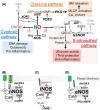
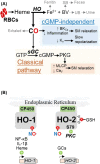
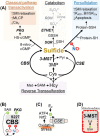
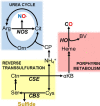

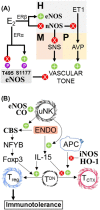

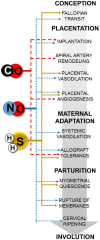
Similar articles
-
Maternal disease and gasotransmitters.Nitric Oxide. 2020 Mar 1;96:1-12. doi: 10.1016/j.niox.2020.01.001. Epub 2020 Jan 3. Nitric Oxide. 2020. PMID: 31911124 Review.
-
Gasotransmitters: growing pains and joys.Trends Biochem Sci. 2014 May;39(5):227-32. doi: 10.1016/j.tibs.2014.03.003. Epub 2014 Apr 22. Trends Biochem Sci. 2014. PMID: 24767680
-
Bioenergetic relevance of hydrogen sulfide and the interplay between gasotransmitters at human cystathionine β-synthase.Biochim Biophys Acta. 2016 Aug;1857(8):1127-1138. doi: 10.1016/j.bbabio.2016.03.030. Epub 2016 Mar 31. Biochim Biophys Acta. 2016. PMID: 27039165 Review.
-
Role of endogenous and exogenous nitric oxide, carbon monoxide and hydrogen sulfide in HCT116 colon cancer cell proliferation.Biochem Pharmacol. 2018 Mar;149:186-204. doi: 10.1016/j.bcp.2017.10.011. Epub 2017 Oct 23. Biochem Pharmacol. 2018. PMID: 29074106 Free PMC article.
-
Do nitric oxide, carbon monoxide and hydrogen sulfide really qualify as 'gasotransmitters' in bacteria?Biochem Soc Trans. 2018 Oct 19;46(5):1107-1118. doi: 10.1042/BST20170311. Epub 2018 Sep 6. Biochem Soc Trans. 2018. PMID: 30190328 Free PMC article. Review.
Cited by
-
Functional Regulation of KATP Channels and Mutant Insight Into Clinical Therapeutic Strategies in Cardiovascular Diseases.Front Pharmacol. 2022 Jun 28;13:868401. doi: 10.3389/fphar.2022.868401. eCollection 2022. Front Pharmacol. 2022. PMID: 35837280 Free PMC article. Review.
-
Gasotransmitters for the Therapeutic Prevention of Hypertension and Kidney Disease.Int J Mol Sci. 2021 Jul 21;22(15):7808. doi: 10.3390/ijms22157808. Int J Mol Sci. 2021. PMID: 34360574 Free PMC article. Review.
-
A Nested Case-Control Study of Allopregnanolone and Preterm Birth in the Healthy Start Cohort.J Endocr Soc. 2022 Nov 24;7(2):bvac179. doi: 10.1210/jendso/bvac179. eCollection 2022 Dec 15. J Endocr Soc. 2022. PMID: 36632210 Free PMC article.
-
Mode Switch of Ca2 + Oscillation-Mediated Uterine Peristalsis and Associated Embryo Implantation Impairments in Mouse Adenomyosis.Front Physiol. 2021 Nov 4;12:744745. doi: 10.3389/fphys.2021.744745. eCollection 2021. Front Physiol. 2021. PMID: 34803733 Free PMC article.
-
Protein kinase A facilitates relaxation of mouse ileum via phosphorylation of neuronal nitric oxide synthase.Br J Pharmacol. 2020 Jun;177(12):2765-2778. doi: 10.1111/bph.15001. Epub 2020 Feb 15. Br J Pharmacol. 2020. PMID: 31975425 Free PMC article.
References
-
- Friebe A, Koesling D. Mechanism of YC-1-induced activation of soluble guanylyl cyclase. Mol Pharmacol 1998; 53(1):123–127. - PubMed
-
- Lewicki JA, Brandwein HJ, Mittal CK, Arnold WP, Murad F. Properties of purified soluble guanylate cyclase activated by nitric oxide and sodium nitroprusside. J Cyclic Nucleotide Res 1982; 8(1):17–25. - PubMed
-
- Kulandavelu S, Whiteley KJ, Qu D, Mu J, Bainbridge SA, Adamson SL. Endothelial nitric oxide synthase deficiency reduces uterine blood flow, spiral artery elongation, and placental oxygenation in pregnant mice. Hypertension 2012; 60(1):231–238. - PubMed
-
- Nuño-Ayala M, Guillén N, Arnal C, Lou-Bonafonte JM, de Martino A, García-de-Jalón JA, Gascón S, Osaba L, Osada J, Navarro MA. Cystathionine β-synthase deficiency causes infertility by impairing decidualization and gene expression networks in uterus implantation sites. Physiol Genomics 2012; 44(14):702–716. - PubMed

